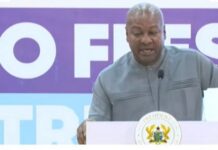Ghana’s total capital expenditure in 2016 exceeded the projected figure of GHC6,393.0 million to GHC7,678.1 million, which is 20.1 per cent higher than the anticipated figure.
The higher overturn was driven partly by higher foreign-financed expenditure, which was on account of higher project loan disbursements.
This is contained in the 2016 State of the Ghanaian Economy Report of the Institute of Statistical, Social and Economic Research (ISSER) of the University of Ghana, launched in Accra, on Wednesday.
The ISSER Annual Report instituted in 1992 provides guidance for policy-makers to make informed judgement on key economic issues since it discusses key economic and development issues facing the country and provides policy recommendations to government.
The Report also serves as a source of information for many researchers, students, scholars and policy-makers.
The 26th Edition of the Report brought together research fellows of the Institute, economic analysts, policy-makers, researchers, policy think tanks and the media.
Professor Felix Ankomah Asante, the Director of the Institute, in a presentation on the Report, said the main policy objective of the government in 2016 was to strengthen the country’s financial position and drive down the overall budget deficit from 6.3 per cent of the Gross Domestic Product (GDP) in 2015 to 5.3 per cent in 2016.
There was an overall budget deficit including divestiture receipts of about GHC15,608 million, representing 9.3 per cent of GDP, up from 7.3 per cent of GDP in 2015, he said.
Prof. Asante noted that government’s revenue as a percentage of GDP decreased by two per cent points from 21.4 per cent in 2015 to 19.4 per cent in 2016.
Moreover, he said, the country’s record high GDP growth of 14 per cent in 2014 could not be sustained in the subsequent years, with a continuing decline to 3.7 per cent in 2016.
He mentioned some reasons for the relative low growth in emerging markets and developing economies as domestic policy weaknesses, tight domestic and external financial conditions, declining oil prices as well as investment and supply constraints.
“Ghana’s GDP grew by 3.7 per cent in 2016, a decline from the 3.8 per cent from the 3.8 per cent in 2015, and thus, continuing the downward trend since 2011,” he said.
Prof. Asante stated that the realised growth rate was below the revised target of 4.1 per cent, adding that, since 2014, non-oil GDP growth had outpaced overall GDP growth, with the gap widening in 2016.
He said the ranking of sectoral growth in 2016 was similar to that of 2015 and 2014, with services recording 5.9 per cent leading the way, followed by agriculture 3.6 per cent, with the industry recording -1.2 per cent.
He noted that the real per capita GDP growth fell from 1.3 per cent in 2015 to 1.0 per cent in 2016, with an end-of-year inflation of 15.4 per cent compared to the target rate of 10.1 per cent.
Dr Anthony Yaw Baah, the General Secretary of the Trade Union Congress (TUC), who chaired the function, said the TUC was concerned about the performance of the economic indicators of the Ghanaian economy because it drove its membership.
He said the data from ISSER was very credible and objective, which many researchers and academicians worldwide used them to analyse the country’s economic environment.
Dr Yaw Baah said the Report had come at an opportune time because the Union could use the data to negotiate for better wages and salaries for its members, while government may use the information to prepare the 2018 Budget and Economic Policy Statement.
He commended the research team of ISSER for compiling the Report and urged the government to allocate funds towards research work in the national budget because research was useful to make better projections.






